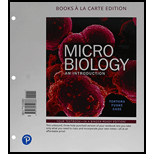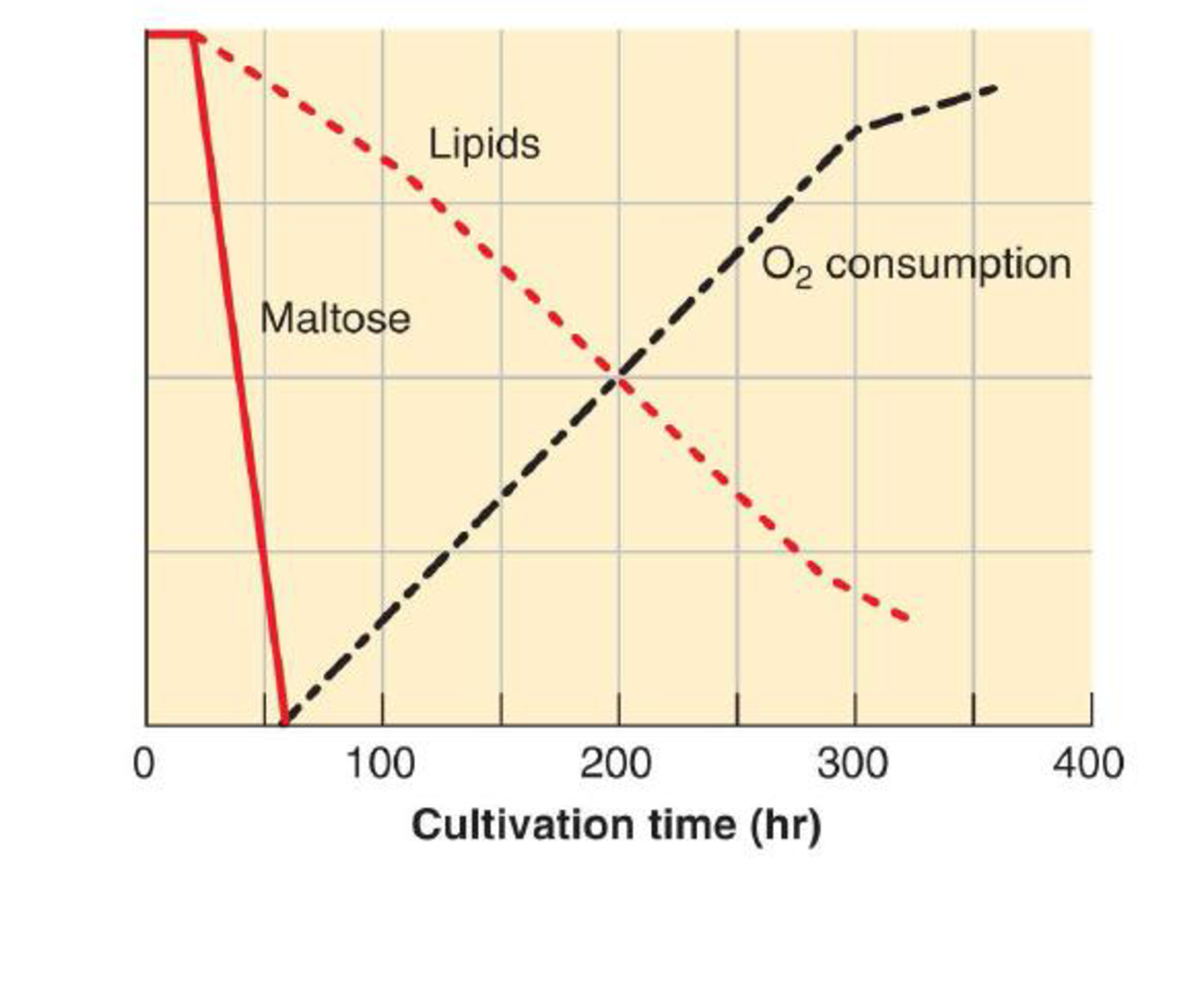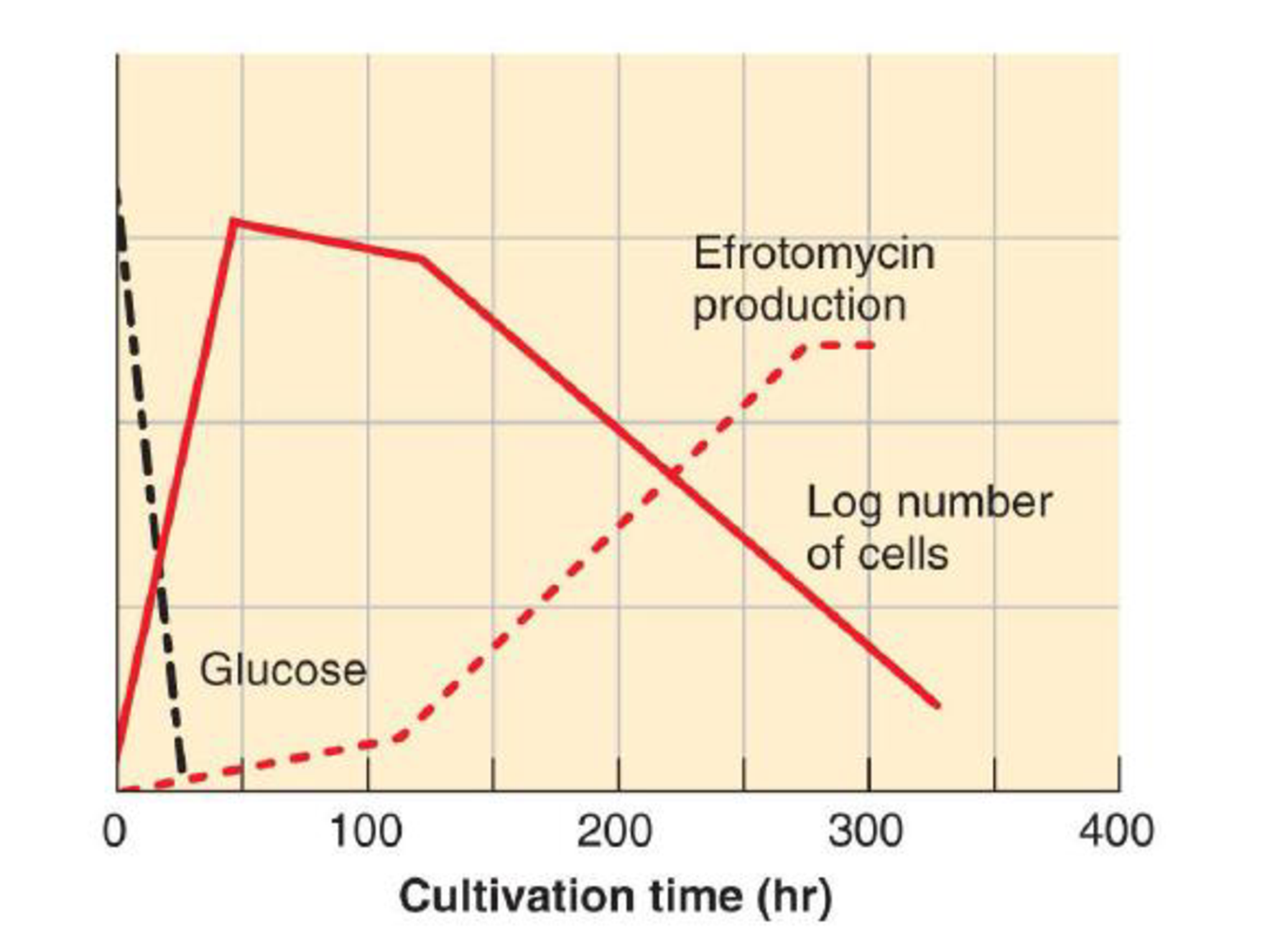
Microbiology: An Introduction, Books a la Carte Plus Mastering Microbiology with Pearson eText -- Access Card Package (13th Edition)
13th Edition
ISBN: 9780134729336
Author: Gerard J. Tortora, Berdell R. Funke, Christine L. Case, Derek Weber, Warner Bair
Publisher: PEARSON
expand_more
expand_more
format_list_bulleted
Concept explainers
Textbook Question
Chapter 28, Problem 3CAE
The antibiotic efrotomycin is produced by Streptomyces lactamdurans. S. lactamdurans was grown in 40,000 liters of medium. The medium consisted of glucose, maltose, soybean oil, (NH4)2SO4, NaCl, KH2PO4, and Na2HPO4. The culture was aerated and maintained at 28°C. The following results were obtained from analyses of the culture medium during cell growth:


- a. Under what conditions is the most efrotomycin produced? Is it a primary or secondary metabolite?
- b. Which is used first, maltose or glucose? Suggest a reason for this.
- c. What is the purpose of each ingredient in the growth medium? (Hint: See Chapter 6.)
- d. What is Streptomyces? (Hint: See Chapter 11.)
Expert Solution & Answer
Want to see the full answer?
Check out a sample textbook solution
Students have asked these similar questions
What did the Cre-lox system used in the Kikuchi et al. 2010 heart regeneration experiment allow researchers to investigate?
What was the purpose of the cmlc2 promoter?
What is CreER and why was it used in this experiment?
If constitutively active Cre was driven by the cmlc2 promoter, rather than an inducible CreER system, what color would you expect new cardiomyocytes in the regenerated area to be no matter what? Why?
What kind of organ size regulation is occurring when you graft multiple organs into a mouse and the graft weight stays the same?
What is the concept "calories consumed must equal calories burned" in regrads to nutrition?
Chapter 28 Solutions
Microbiology: An Introduction, Books a la Carte Plus Mastering Microbiology with Pearson eText -- Access Card Package (13th Edition)
Ch. 28 - What is industrial microbiology? Why is it...Ch. 28 - How does commercial sterilization differ from...Ch. 28 - Why is a can of blackberries preserved by...Ch. 28 - Outline the steps in the production of cheese, and...Ch. 28 - Beer is made with water, malt, and yeast; hops are...Ch. 28 - Why is a bioreactor better than a large flask for...Ch. 28 - The manufacture of paper includes the use of...Ch. 28 - Describe an example of bioconversion. What...Ch. 28 - Prob. 9RCh. 28 - NAME IT Van Leeuwenhoek was the first to see this...
Ch. 28 - Foods packed in plastic for microwaving are a....Ch. 28 - Acetobacter is necessary for only one of the steps...Ch. 28 - Use the following choices to answer questions 35:...Ch. 28 - The spoilage of canned foods caused by Geobacillus...Ch. 28 - A heat-resistant fungus that causes spoilage in...Ch. 28 - The term 12D treatment refers to a. heat treatment...Ch. 28 - Which one of the following is not a fuel produced...Ch. 28 - Which type of radiation is used to preserve foods?...Ch. 28 - Which of the following reactions is undesirable in...Ch. 28 - Which of the following reactions is an oxidation...Ch. 28 - Which bacteria seem to be most frequently used in...Ch. 28 - Methylophilus methylotrophus can convert methane...Ch. 28 - Faded worn-look denim is produced with cellulase....Ch. 28 - Suppose you are culturing a microorganism that...Ch. 28 - Researchers at the CDC inoculated apple cider with...Ch. 28 - The antibiotic efrotomycin is produced by...
Additional Science Textbook Solutions
Find more solutions based on key concepts
Label each statement about the polynucleotide ATGGCG as true or false. The polynucleotide has six nucleotides. ...
General, Organic, and Biological Chemistry - 4th edition
Why do scientists think that all forms of life on earth have a common origin?
Genetics: From Genes to Genomes
4.1 Write the symbols for the following elements.
a. copper
b. platinum
c. calcium
d. manganese
e. Iron
...
Chemistry: An Introduction to General, Organic, and Biological Chemistry (13th Edition)
Gregor Mendel never saw a gene, yet he concluded that some inherited factors were responsible for the patterns ...
Campbell Essential Biology (7th Edition)
Knowledge Booster
Learn more about
Need a deep-dive on the concept behind this application? Look no further. Learn more about this topic, biology and related others by exploring similar questions and additional content below.Similar questions
- You intend to insert patched dominant negative DNA into the left half of the neural tube of a chick. 1) Which side of the neural tube would you put the positive electrode to ensure that the DNA ends up on the left side? 2) What would be the internal (within the embryo) control for this experiment? 3) How can you be sure that the electroporation method itself is not impacting the embryo? 4) What would you do to ensure that the electroporation is working? How can you tell?arrow_forwardDescribe a method to document the diffusion path and gradient of Sonic Hedgehog through the chicken embryo. If modifying the protein, what is one thing you have to consider in regards to maintaining the protein’s function?arrow_forwardThe following table is from Kumar et. al. Highly Selective Dopamine D3 Receptor (DR) Antagonists and Partial Agonists Based on Eticlopride and the D3R Crystal Structure: New Leads for Opioid Dependence Treatment. J. Med Chem 2016.arrow_forward
- The following figure is from Caterina et al. The capsaicin receptor: a heat activated ion channel in the pain pathway. Nature, 1997. Black boxes indicate capsaicin, white circles indicate resinferatoxin. You are a chef in a fancy new science-themed restaurant. You have a recipe that calls for 1 teaspoon of resinferatoxin, but you feel uncomfortable serving foods with "toxins" in them. How much capsaicin could you substitute instead?arrow_forwardWhat protein is necessary for packaging acetylcholine into synaptic vesicles?arrow_forward1. Match each vocabulary term to its best descriptor A. affinity B. efficacy C. inert D. mimic E. how drugs move through body F. how drugs bind Kd Bmax Agonist Antagonist Pharmacokinetics Pharmacodynamicsarrow_forward
- 50 mg dose of a drug is given orally to a patient. The bioavailability of the drug is 0.2. What is the volume of distribution of the drug if the plasma concentration is 1 mg/L? Be sure to provide units.arrow_forwardDetermine Kd and Bmax from the following Scatchard plot. Make sure to include units.arrow_forwardChoose a catecholamine neurotransmitter and describe/draw the components of the synapse important for its signaling including synthesis, packaging into vesicles, receptors, transporters/degradative enzymes. Describe 2 drugs that can act on this system.arrow_forward
- The following figure is from Caterina et al. The capsaicin receptor: a heat activated ion channel in the pain pathway. Nature, 1997. Black boxes indicate capsaicin, white circles indicate resinferatoxin. a) Which has a higher potency? b) Which is has a higher efficacy? c) What is the approximate Kd of capsaicin in uM? (you can round to the nearest power of 10)arrow_forwardWhat is the rate-limiting-step for serotonin synthesis?arrow_forwardWhat enzyme is necessary for synthesis of all of the monoamines?arrow_forward
arrow_back_ios
SEE MORE QUESTIONS
arrow_forward_ios
Recommended textbooks for you
 Comprehensive Medical Assisting: Administrative a...NursingISBN:9781305964792Author:Wilburta Q. Lindh, Carol D. Tamparo, Barbara M. Dahl, Julie Morris, Cindy CorreaPublisher:Cengage Learning
Comprehensive Medical Assisting: Administrative a...NursingISBN:9781305964792Author:Wilburta Q. Lindh, Carol D. Tamparo, Barbara M. Dahl, Julie Morris, Cindy CorreaPublisher:Cengage Learning Microbiology for Surgical Technologists (MindTap ...BiologyISBN:9781111306663Author:Margaret Rodriguez, Paul PricePublisher:Cengage Learning
Microbiology for Surgical Technologists (MindTap ...BiologyISBN:9781111306663Author:Margaret Rodriguez, Paul PricePublisher:Cengage Learning



Comprehensive Medical Assisting: Administrative a...
Nursing
ISBN:9781305964792
Author:Wilburta Q. Lindh, Carol D. Tamparo, Barbara M. Dahl, Julie Morris, Cindy Correa
Publisher:Cengage Learning

Microbiology for Surgical Technologists (MindTap ...
Biology
ISBN:9781111306663
Author:Margaret Rodriguez, Paul Price
Publisher:Cengage Learning


QCE Biology: Introduction to Gene Expression; Author: Atomi;https://www.youtube.com/watch?v=a7hydUtCIJk;License: Standard YouTube License, CC-BY